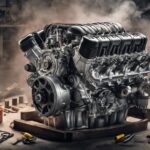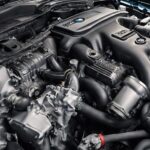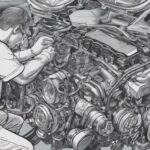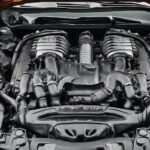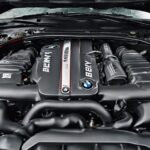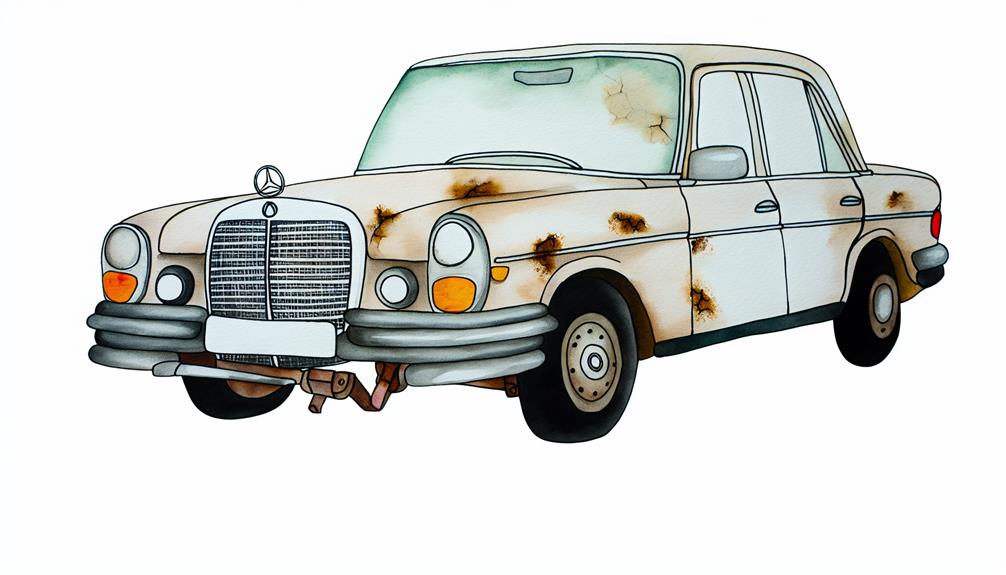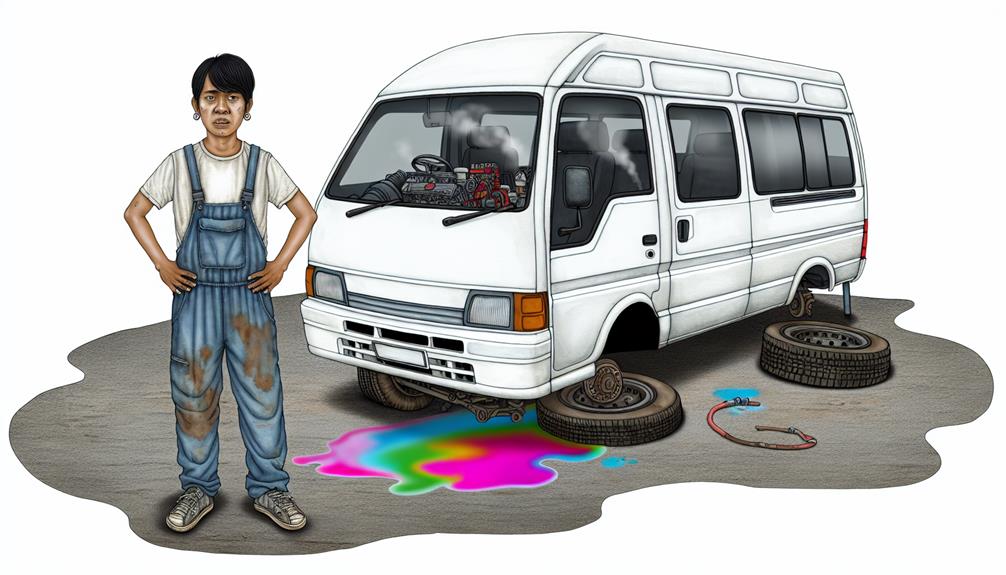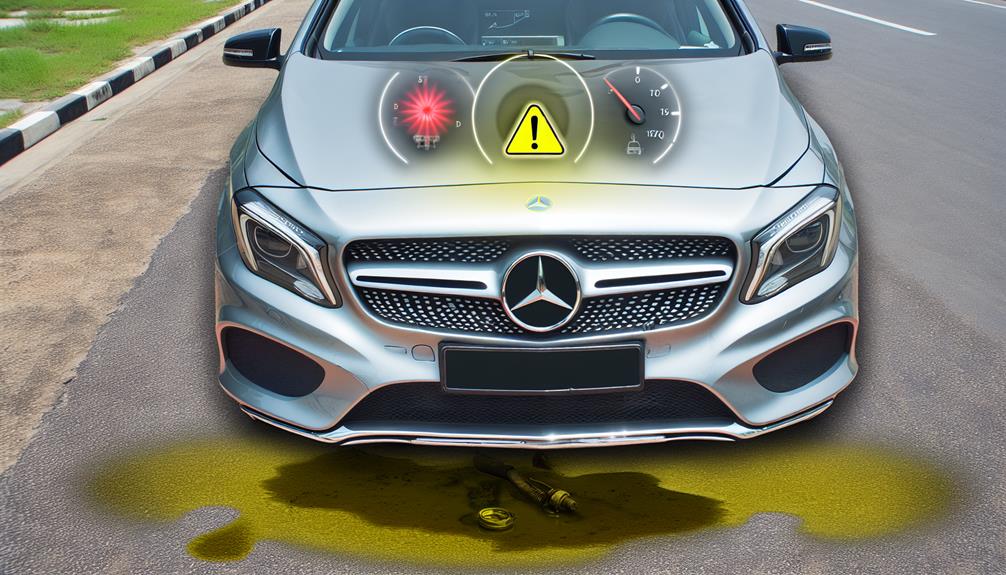If you possess a Mercedes W126, be cautious of common issues like self-leveling suspension problems caused by fuel leaks, corrosion in critical body areas, and electrical malfunctions affecting various components. Keep an eye on engine oil leaks that can lead to serious damage, air conditioning faults like refrigerant leaks, and hydraulic steering system faults manifesting in leaks and steering issues. Also, be cautious of automatic transmission problems such as erratic shifting and fluid leaks. Regular maintenance is crucial to detecting and preventing major issues. Be sure to address these problems promptly to maintain your vehicle's performance and value.
Key Takeaways
- Suspension system issues due to fuel leaks and deteriorating seals.
- Bodywork rust problems in wheel arches and lower body sections.
- Electrical system malfunctions affecting wiring harness and power windows.
- Engine oil leaks from sources like timing cover and main seal.
- Air conditioning faults including refrigerant leaks and compressor failures.
Self-Leveling Suspension Issues

If you own a Mercedes W126, you may encounter various self-leveling suspension issues that can impact the performance and ride comfort of your vehicle. One common problem with the self-leveling suspension system in these models is fuel leaks. These leaks can occur due to deteriorating seals or damaged hydraulic lines, leading to a loss of hydraulic fluid necessary for the proper functioning of the suspension. Regular maintenance of the hydraulic components is essential to prevent such issues.
It's recommended to inspect the system for any signs of leaks and address them promptly to avoid further damage. Ignoring fuel leaks can result in a compromised suspension system, leading to uneven ride height and potentially unsafe driving conditions. Therefore, staying proactive with maintenance items related to the self-leveling suspension can guarantee a smooth and comfortable driving experience in your Mercedes W126.
Bodywork Rust Problems
Regularly inspecting the wheel arches, floor pans, and lower body sections of your Mercedes W126 is vital to detect and address potential bodywork rust problems. Bodywork rust can be a common issue in these models and addressing it promptly is important to prevent structural weaknesses and costly repairs down the line.
Here are some key points to keep in mind regarding bodywork rust in your Mercedes W126:
- Early Detection: By inspecting the mentioned areas regularly, you can catch rust problems in their early stages, making repairs more manageable and less expensive.
- Prevent Structural Damage: Ignoring bodywork rust can lead to structural weaknesses, compromising the integrity of your Mercedes W126. Addressing rust promptly helps maintain the vehicle's strength and safety.
- Preserve Aesthetics: Rust not only impacts the structural integrity but also affects the visual appeal of your Mercedes W126. Taking care of rust issues promptly can help preserve the aesthetic appeal of your vehicle, ensuring it looks good for years to come.
Electrical System Malfunctions
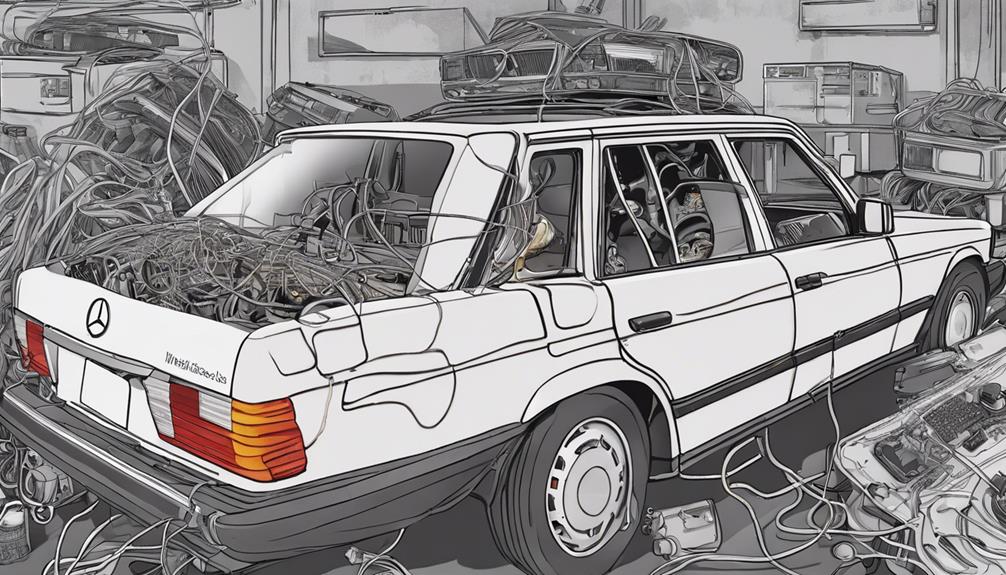
When facing electrical system malfunctions in your Mercedes W126, addressing them promptly is vital to guarantee the vehicle's peak functionality and performance. Common issues in the electrical system of Mercedes W126 include problems with the wiring harness, power window regulators, and climate control vacuum system.
These malfunctions can lead to failures in components like switches, relays, and fuses, affecting the lights, dashboard instruments, and various sensors in the car. To troubleshoot these problems effectively, specialized diagnostic tools and expertise may be required.
Regular inspection and maintenance of the electrical system are essential to prevent major malfunctions and ensure the smooth operation of your vehicle. Additionally, keeping a detailed service history can aid in diagnosing recurring electrical issues and maintaining the best fuel economy.
Engine Oil Leaks
Engine oil leaks in Mercedes W126 models commonly stem from the timing cover and main seal, necessitating immediate attention to prevent potential engine damage. Addressing these leaks is vital to maintain the engine's health and performance.
- Timing Chain: A worn timing cover gasket can lead to oil seepage onto the timing chain, causing premature wear and potential timing issues. Regular inspection and timely replacement of the gasket are vital to prevent costly repairs.
- Fuel System: Oil leaks near the main seal can contaminate the fuel system, affecting its performance and leading to decreased fuel efficiency. Resolving main seal leaks promptly can help maintain the ideal function of the fuel system and prevent further complications.
- Preventive Maintenance: Regularly checking for oil leaks, especially around the timing cover and main seal, can help detect issues early. Timely intervention by replacing worn gaskets and seals can prevent extensive damage and costly repairs down the road.
Air Conditioning System Faults
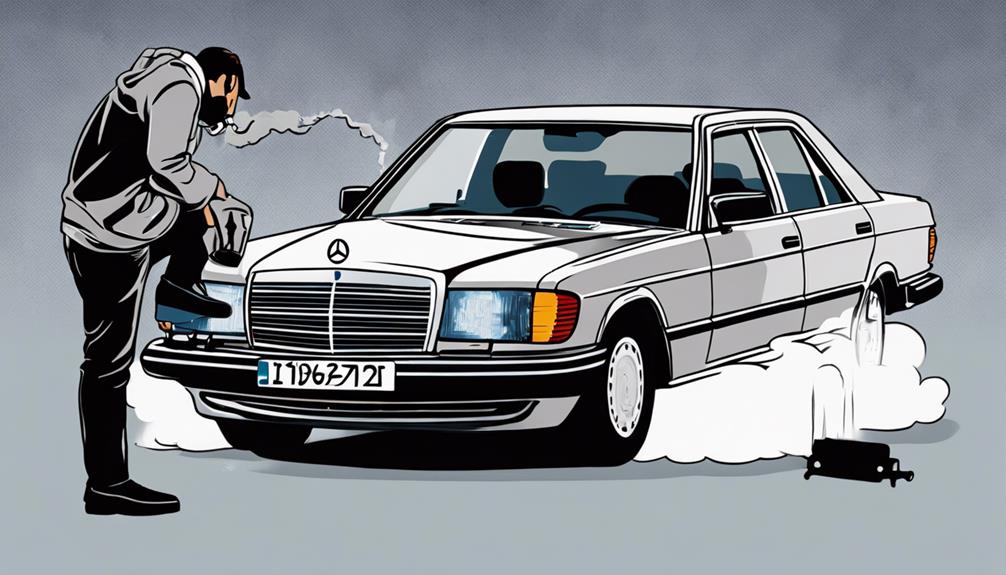
If you're experiencing cooling performance issues or suspect refrigerant leaks in your Mercedes W126, addressing these air conditioning system faults is essential.
Issues like lack of cold air or strange odors may indicate underlying problems that need attention.
Checking refrigerant levels and inspecting components can help identify and resolve these issues promptly.
Cooling Performance Issues
Cooling performance issues in Mercedes W126 models often stem from air conditioning system faults that can lead to costly repairs. When your climate control system isn't functioning at its best, it can result in discomfort during your drives. Here are some common cooling issues to watch out for:
- Refrigerant Leaks: Loss of refrigerant can impair cooling efficiency.
- Compressor Failures: A malfunctioning compressor may lead to inadequate cooling.
- Evaporator Problems: Issues with the evaporator can impact the system's ability to cool the air effectively.
Regular maintenance and timely repairs are essential in ensuring your air conditioning system operates at its peak, providing you with a pleasant driving experience.
Refrigerant Leaks
Refrigerant leaks in the air conditioning system of Mercedes W126 models can greatly impact cooling performance and should be promptly addressed to maintain peak function. These leaks not only lead to reduced cooling efficiency but can also pose environmental risks.
Detecting and repairing refrigerant leaks promptly is critical for ensuring the proper operation of the air conditioning system. Seeking professional help for diagnosis and repair is often necessary to effectively address these leaks.
Regular maintenance and inspection of the air conditioning system are essential in preventing and managing refrigerant leaks. By staying proactive and addressing these issues promptly, you can guarantee that your Mercedes W126's air conditioning system functions optimally and efficiently.
Climate Control Unit Issues
You may encounter issues with the climate control unit in your Mercedes W126, such as control panel malfunctions and temperature regulation problems. These problems can stem from faulty sensors, worn-out switches, or malfunctioning actuators, leading to inconsistent temperature settings or even a complete system failure.
Addressing these climate control unit issues promptly is essential to maintain a comfortable driving experience and prevent further complications down the road.
Control Panel Malfunctions
When experiencing control panel malfunctions in the Mercedes W126, addressing these issues promptly is important to guarantee optimal climate control functionality. Here are some common problems associated with control panel malfunctions:
- Faulty Switches: Malfunctioning switches can lead to an inability to adjust temperature settings effectively.
- Inoperative Buttons: Non-responsive buttons can hinder proper control of the climate settings.
- Erratic Temperature Adjustments: Fluctuating temperatures inside the vehicle due to control panel malfunctions can result in discomfort during your drive.
Ensuring that the climate control unit operates smoothly is essential for a pleasant driving experience in your Mercedes W126. Regular maintenance and timely repairs can help prevent these issues from affecting your comfort.
Temperature Regulation Problems
Temperature regulation problems within the climate control unit of the Mercedes W126 often stem from faulty components such as capacitors and resistors, leading to erratic temperature adjustments and unresponsive controls.
When faced with these issues, seeking expertise in electronic diagnostics is essential for accurate identification and repair. Symptoms like inconsistent heating or cooling can disrupt your driving experience, emphasizing the importance of addressing climate control unit malfunctions promptly.
Repairing the faulty components may restore proper functionality, but in some cases, upgrading to modern electronic climate control systems could offer increased reliability.
Hydraulic Steering System Faults
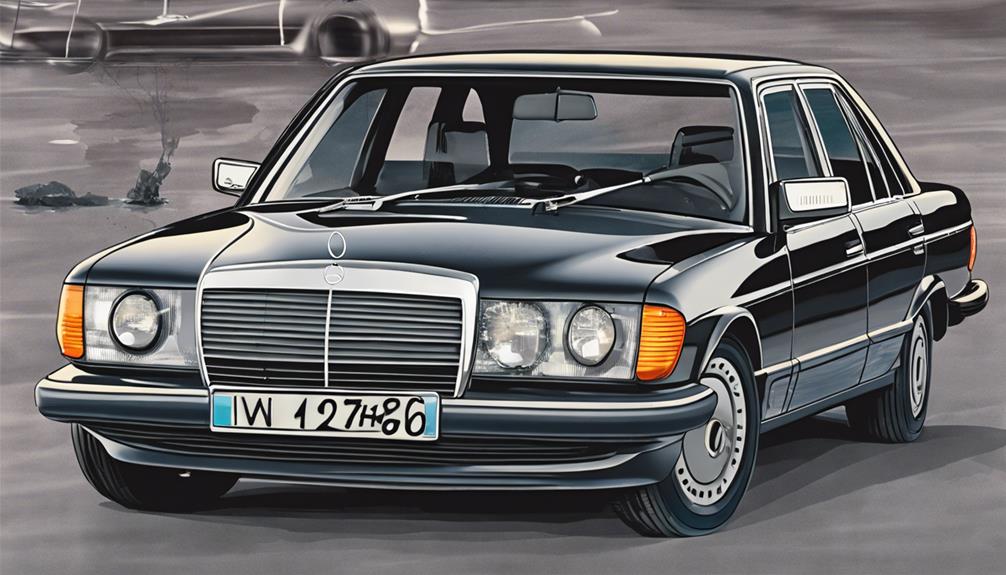
Developing leaks in the steering gearbox, pump, or hoses is a common issue with the hydraulic steering system of Mercedes W126. These faults can lead to steering stiffness and a loss of power assistance, affecting the overall driving experience.
To help you better understand the hydraulic steering system faults in your Mercedes W126, here are some key points to keep in mind:
- Fluid Leaks: Leaks in the steering gearbox, pump, or hoses can result in steering fluid contamination or low fluid levels, compromising the system's performance.
- Symptoms: Look out for steering wheel vibration, unusual noises while turning, or experiencing difficulty when trying to maneuver the vehicle, as these could indicate underlying hydraulic steering issues.
- Preventive Maintenance: Regular inspection and maintenance of the hydraulic steering system are essential to prevent major steering problems. By addressing leaks and other issues promptly, you can maintain smooth and efficient steering functionality in your Mercedes W126.
Automatic Transmission Problems
If you're experiencing shifting issues or noticing fluid leaks in your Mercedes W126, it could be indicative of automatic transmission problems.
These common issues may stem from worn-out clutches or faulty solenoids, affecting the smooth operation of the transmission system.
Paying attention to delayed or erratic shifting patterns, especially during cold starts, can help you catch potential transmission problems early on.
Shifting Issues
Shifting problems in Mercedes W126 automatic transmissions often stem from worn out or failing components, leading to symptoms such as delayed shifting, harsh shifting, or slipping gears. When encountering shifting issues, it's important to address them promptly to prevent further damage.
Here are three key points to keep in mind:
- Fluid Checks: Regularly inspecting the transmission fluid level and quality is vital in maintaining proper function.
- Maintenance Matters: Timely servicing and repairs can help avoid transmission problems associated with wear and tear.
- Professional Attention: Seeking assistance from a qualified mechanic familiar with Mercedes W126 transmissions can diagnose and resolve shifting issues accurately.
Fluid Leaks
Fluid leaks in the automatic transmission of Mercedes W126 models commonly stem from deteriorated seals, gaskets, or transmission components, potentially leading to performance issues and costly damage if left unattended. Leaking transmission fluid not only affects the transmission's ability to function correctly but also poses a risk of fire due to the fluid's flammability. Older models are particularly prone to these leaks as the seals and gaskets degrade over time. It is essential to address any signs of transmission fluid leaks promptly to prevent fuel inefficiency and more severe damage. Regular maintenance and inspection can help detect and repair these leaks early, ensuring the longevity and efficiency of your Mercedes W126.
| Common Signs of Fluid Leaks | Potential Risks | Solutions |
|---|---|---|
| Puddles under the car | Transmission failure | Replace seals and gaskets |
| Burnt smell in the cabin | Fire hazard | Check and repair components |
| Difficulty shifting gears | Reduced fuel efficiency | Regular fluid checks |
Regular Maintenance Requirements

To maintain your Mercedes W126 in prime condition, addressing rust issues in the wheel arches and floor pans promptly is essential. Keeping up with regular maintenance requirements can help prolong the life of your beloved vehicle. Here are some key points to ponder:
- Inspect and Treat Rust: Regularly check for rust in the wheel arches and floor pans, especially if you use your Mercedes W126 as a daily driver. Promptly treat any rust spots to prevent further corrosion.
- Maintain Air Suspension: Proper maintenance of the air suspension system is critical for a smooth ride. Check for leaks, guarantee proper pressurization, and address any issues promptly to avoid costly repairs.
- Fuel System Cleaning: As a part of routine maintenance, cleaning and inspecting the fuel system is essential for the overall health of your Mercedes W126. Regular maintenance of components like the fuel pump can prevent breakdowns and ensure top-notch performance.
Potential Repair Needs
When addressing potential repair needs for your Mercedes W126, it's essential to be vigilant about common issues that may arise. These include rust problems in various body sections, electrical malfunctions, air suspension issues, and engine or transmission complications.
As a classic car owner, understanding these potential repair needs can help you uphold the vehicle's performance and value. Rust problems often manifest in wheel arches, floor pans, and lower body sections, requiring timely intervention to guarantee further damage.
Electrical issues like wiring harness malfunctions and power window regulator failures are common and may impact the car's overall functionality. Air suspension problems, such as air leaks or failing components, should be addressed promptly to maintain a smooth ride.
Additionally, engine issues like engine mount problems or transmission complications, such as shifting issues, may necessitate expert attention to keep your Mercedes W126 running smoothly.
Frequently Asked Questions
What Is the Problem With the Mercedes W126?
You experience various issues with your Mercedes W126, like rust affecting wheel arches, floor pans, and lower body sections. Electrical problems, air suspension issues, engine and transmission challenges, and fuel system malfunctions are common. Regular maintenance helps prevent these issues.
Is the W126 a Classic?
Yes, the W126 is undeniably a classic. Its luxurious features, advanced safety technology, and timeless design have solidified its status. Enthusiasts appreciate its craftsmanship and performance, maintaining its value among collectors.
What Is the Mpg of Mercedes W126?
The Mercedes W126 typically achieves around 20MPG in fuel efficiency. You might notice a lack of power at start due to engine characteristics. Vacuum issues at idle can affect performance. Locating local parts may be tricky.
How Many Mercedes W126 Were Made?
Approximately 818,036 Mercedes W126 vehicles were manufactured, showcasing a range of models, including sedans, long-wheelbase sedans, and coupes. The W126, produced from 1979 to 1991, stands out as a classic icon known for luxury and innovation.
Conclusion
Overall, the Mercedes W126 may experience common issues such as:
- self-leveling suspension problems
- bodywork rust
- electrical malfunctions
- engine oil leaks
- air conditioning faults
- hydraulic steering issues
- automatic transmission problems
- regular maintenance needs
It's important to address these issues promptly to guarantee the longevity and performance of your vehicle.
Stay diligent in monitoring and maintaining your Mercedes W126 to prevent costly repairs in the future.
